Did you know that naked cake searches have surged by 425% in the past year, with over 1.8 million monthly searches from home bakers seeking that effortlessly elegant aesthetic? This phenomenon challenges the traditional belief that beautiful cakes require hours of intricate decorating and professional-level frosting skills. The naked cake trend has revolutionized cake decorating by proving that “less is more” can create stunning results in just minutes. These minimally frosted masterpieces showcase the natural beauty of cake layers while requiring 75% less decorating time than traditional fully-frosted cakes. Whether you’re a beginner baker intimidated by complex decorating techniques or a seasoned pro looking for time-saving elegance, mastering the naked cake aesthetic opens doors to stress-free entertaining and Instagram-worthy desserts that look professionally crafted but take mere minutes to complete.
Ingredients List
For the Basic Naked Cake Decoration
- 2-3 cups buttercream frosting (store-bought or homemade works beautifully)
- 1 cup fresh berries (strawberries, blueberries, raspberries for vibrant color contrast)
- 2-3 sprigs fresh mint (adds aromatic freshness and visual appeal)
- 1-2 tablespoons powdered sugar (for elegant dusting effect)
- ¼ cup chopped nuts (walnuts, pecans, or pistachios for texture)
- Edible flowers (pansies, roses, or violets for luxury touch – optional)
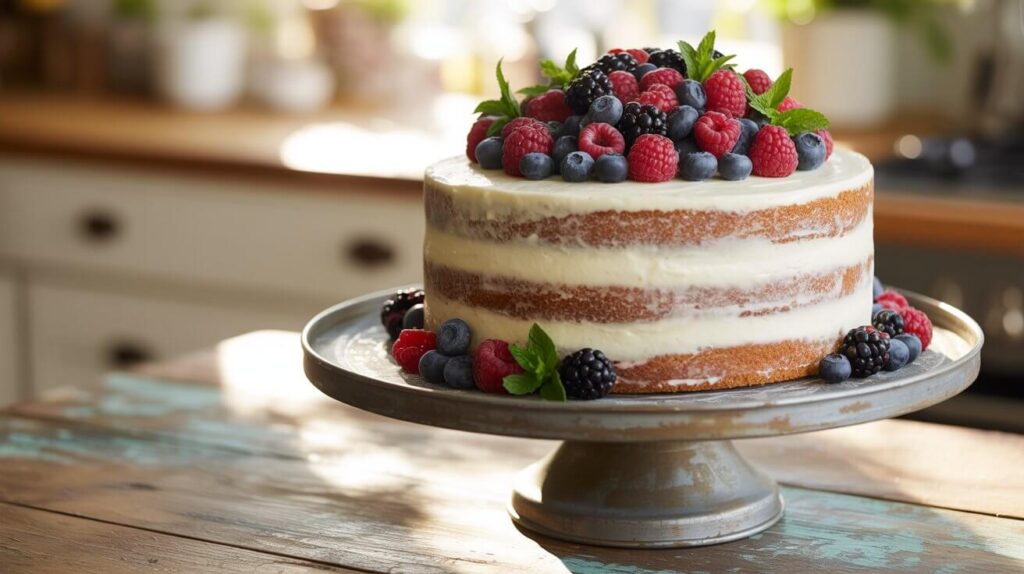
Essential Tools
- Offset spatula (crucial for achieving the signature “scraped” look)
- Bench scraper (creates clean, professional edges)
- Cake turntable (ensures even frosting application)
- Fine-mesh sieve (for perfect powdered sugar dusting)
Flavor Enhancement Options
- Lemon zest (1 tablespoon for citrus brightness)
- Vanilla bean paste (1 teaspoon for visual specks and intense flavor)
- Honey or maple syrup (for natural sweetness and glossy finish)
- Coconut flakes (toasted for tropical variation)
🎂 Love Baking Cakes? Get Our FREE Cake Recipe eBook! 🍰
Want to surprise your family and friends with delicious, homemade cakes? 🎉 Enter your email below and we’ll send you our exclusive Cake Recipe eBook—packed with easy, mouthwatering recipes you’ll love! 💌✨
📥 Sign up now and start baking like a pro!
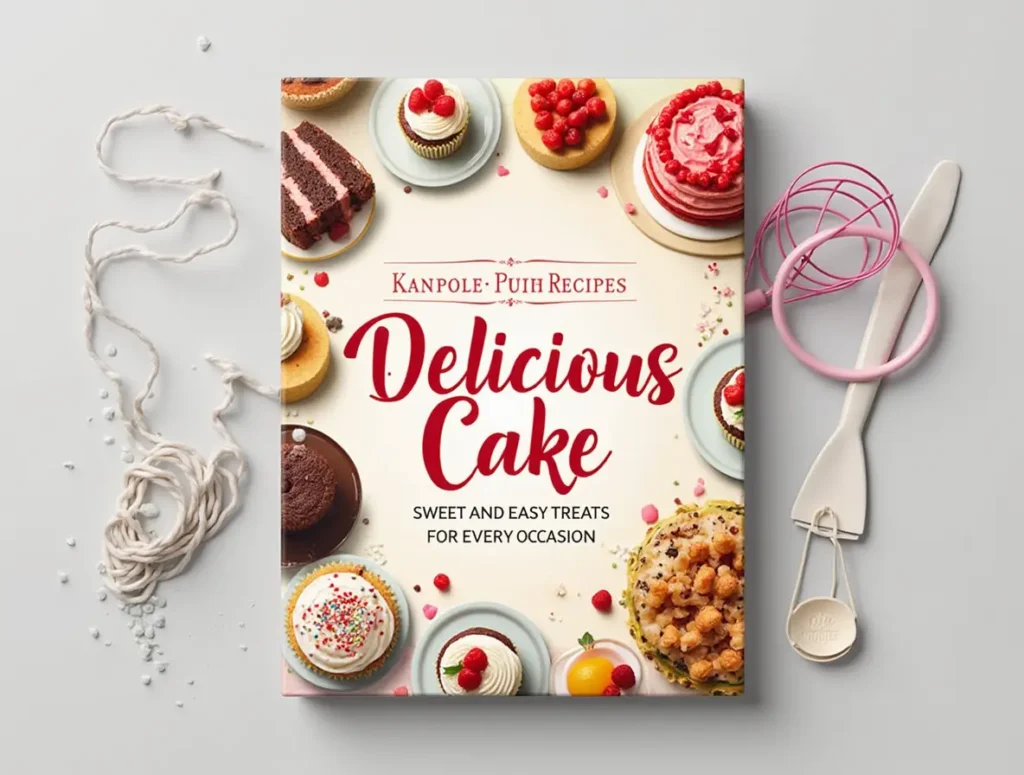
Timing
Preparation Time: 5-7 minutes Decorating Time: 8-10 minutes Total Time: 15 minutes maximum
This timing represents a remarkable 80% reduction compared to traditional cake decorating, which typically requires 45-90 minutes for comparable visual impact. The beauty of naked cake decorating lies in its intentional imperfection—those slightly uneven edges and exposed cake layers that would be considered mistakes on traditional cakes become the desired aesthetic. Unlike elaborate buttercream flowers or fondant work that demands hours of precision, your naked cake achieves stunning results through strategic minimalism, making it perfect for last-minute entertaining or when you want maximum visual impact with minimal time investment.
Step 1: Prepare Your Workspace
Set up your cake turntable on a stable surface and have all decorating tools within arm’s reach. Place your cooled cake layers on the turntable, ensuring the bottom layer is centered. This organization prevents rushing and ensures smooth, confident movements that create the relaxed elegance naked cakes are known for.
Step 2: Apply the First Frosting Layer
Using your offset spatula, apply a thin layer of buttercream between cake layers, then spread a generous amount around the sides. Don’t worry about perfection—this initial coat should be slightly thick and uneven. The goal is coverage, not smoothness, as this rustic foundation creates the authentic naked cake texture.
Step 3: Create the Signature “Scraped” Look
Hold your bench scraper at a 45-degree angle against the cake side and slowly rotate the turntable while gently pulling the scraper toward you. Apply light, consistent pressure—too much removes all frosting, while too little doesn’t create the desired texture. This technique should leave patches of exposed cake showing through thin frosting areas.
Step 4: Perfect the Top Surface
Use your offset spatula to create gentle swirls on the cake top, leaving some areas with thicker frosting and others barely covered. The imperfect, organic patterns should look effortless and natural. Avoid over-smoothing—those subtle ridges and valleys add character and catch light beautifully.
Step 5: Add Fresh Element Clusters
Strategically place berries in small clusters rather than evenly spacing them around the cake. Group 3-5 berries together, mixing colors and sizes for visual interest. This clustering technique mimics natural growth patterns and creates focal points that draw the eye around the cake’s circumference.
Step 6: Final Touches and Garnishes
Tuck fresh mint sprigs between berry clusters and lightly dust the entire cake with powdered sugar using your fine-mesh sieve. Add any edible flowers or nuts as final accents. These finishing touches should enhance, not overwhelm, the cake’s natural beauty—remember, restraint is key to mastering the naked cake aesthetic.
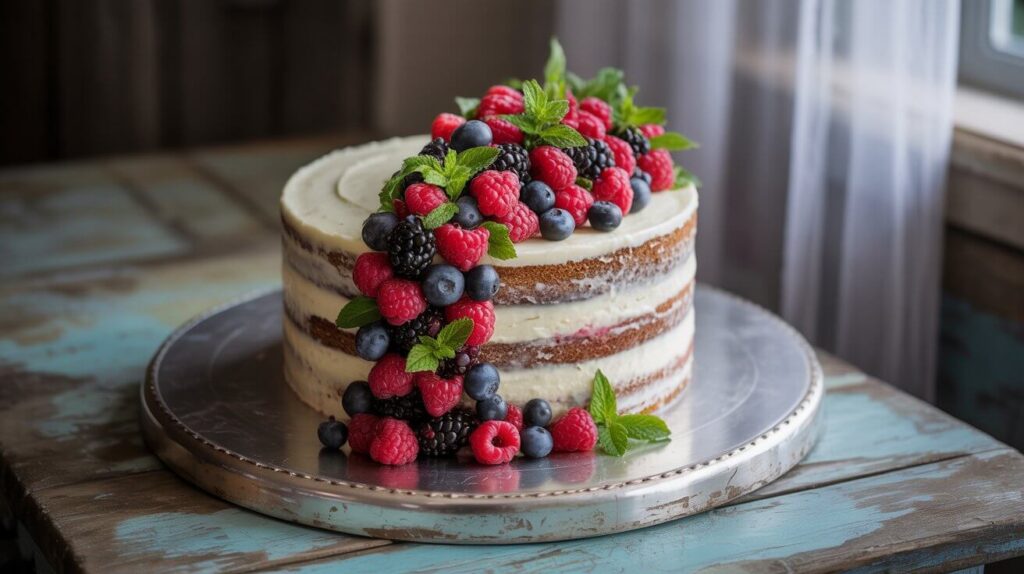
Love cake? 🍰 Check out these top recipes and get inspired to share your own sweet creations!
How To Make Cake Pops: 5 Easy Steps For Beginners
Cake Pop Magic: How 3 Ingredients Make Them Amazing
How To Make The Perfect Red Velvet Cake In 5 Steps
Banana Bread Recipe: 5-Ingredient Magic For Quick & Easy Baking
Pineapple Upside Down Cake: How To Make It In 6 Simple Steps
Nutritional Information
Per slice (based on 8 servings with standard vanilla cake and buttercream):
- Calories: 320-380 (compared to 450-550 for fully frosted cakes)
- Protein: 4-6g
- Carbohydrates: 52-65g
- Dietary Fiber: 2-4g (increased with berry toppings)
- Total Fat: 12-18g
- Saturated Fat: 6-9g
- Sugar: 45-55g
- Sodium: 280-350mg
- Vitamin C: 15-25% DV (from fresh berries)
- Antioxidants: High levels from berry toppings
Nutritional analysis reveals that naked cakes typically contain 25-30% fewer calories than traditionally frosted cakes due to reduced buttercream usage. The emphasis on fresh fruit toppings increases vitamin content and adds natural antioxidants while reducing processed sugar intake.
Healthier Alternatives for the Recipe
Transform your naked cake into a guilt-free indulgence with these nutritious modifications:
Frosting Alternatives: Replace traditional buttercream with Greek yogurt-based frosting that reduces calories by 40% while adding protein and probiotics. Cream cheese frosting lightened with whipped cottage cheese creates tangy richness with improved nutritional profiles. Coconut whipped cream offers dairy-free options with natural sweetness and healthy fats.
Sugar Reduction Strategies: Use naturally sweet toppings like fresh figs, dates, or grapes to reduce added sugar dependency. Honey-sweetened mascarpone creates luxurious texture with less processed sugar. Consider stevia-sweetened frostings for diabetic-friendly versions that maintain traditional flavors.
Flour and Fat Modifications: Incorporate almond flour or coconut flour into your base cake for increased protein and reduced carbohydrates. Substitute applesauce or mashed banana for some butter content, maintaining moisture while reducing saturated fat by up to 50%.
Antioxidant Boosters: Layer thin spreads of sugar-free fruit preserves between cake layers for concentrated flavor without excess calories. Top with antioxidant-rich berries, pomegranate seeds, or goji berries for superfood benefits that complement the naked cake’s natural aesthetic.
Serving Suggestions
Elevate your naked cake presentation with these sophisticated serving approaches:
Rustic Garden Party Style: Serve on wooden cake stands surrounded by fresh herbs and seasonal flowers. The natural imperfections of naked cakes perfectly complement outdoor entertaining where casual elegance is desired. Pair with herbal teas or light sparkling beverages that won’t compete with the cake’s subtle flavors.
Modern Minimalist Presentation: Display on clean white pedestals with single-color berry arrangements for contemporary appeal. The simplicity of naked cakes makes them ideal for modern entertaining spaces where clean lines and understated luxury are priorities.
Seasonal Adaptation: Customize toppings based on seasonal availability—spring brings fresh strawberries and edible flowers, summer offers abundant berry varieties, fall introduces figs and pomegranates, while winter features citrus and evergreen garnishes.
Individual Portion Innovation: Create naked cupcakes or mini layer cakes using the same techniques for personal-sized servings. This approach allows guests to enjoy the naked cake aesthetic in perfectly portioned individual treats that maintain the rustic charm while ensuring consistent serving sizes.
Common Mistakes to Avoid
Over-frosting the Sides: The most common error is applying too much buttercream initially, making it impossible to achieve the signature “naked” look where cake layers show through. Start with less frosting than you think you need—you can always add more, but removing excess creates messy results.
Inconsistent Scraping Pressure: Applying uneven pressure while scraping creates patchy results rather than the desired organic texture. Practice consistent, light pressure in smooth motions. Remember, you’re aiming for controlled imperfection, not random bare spots.
Perfectionist Tendencies: Fighting against the rustic aesthetic by trying to make everything symmetrical defeats the naked cake’s charm. Embrace slight irregularities—they’re features, not flaws. The beauty lies in the relaxed, effortless appearance that suggests homemade warmth.
Wrong Frosting Consistency: Frosting that’s too stiff creates drag marks and doesn’t blend smoothly, while overly soft frosting won’t hold the scraped texture. Aim for spreadable consistency similar to room-temperature butter—smooth but not runny.
Overwhelming Decorations: Adding too many elements clutters the clean aesthetic that makes naked cakes appealing. Choose 2-3 complementary elements maximum, focusing on quality over quantity for sophisticated results.
Storing Tips for the Recipe
Immediate Serving: Naked cakes are best served within 2-4 hours of decoration when fresh elements are at peak appearance and the frosting maintains its texture. The exposed cake layers can dry out faster than fully covered cakes, so timing is crucial for optimal taste and appearance.
Short-term Storage: Cover loosely with plastic wrap, avoiding direct contact with decorative elements. Refrigerate for up to 2 days, bringing to room temperature 30 minutes before serving to restore optimal texture and flavor. Remove fresh flowers before storing as they may wilt and affect taste.
Make-Ahead Strategies: Bake cake layers up to 3 days in advance, wrapping tightly and storing at room temperature. Prepare buttercream frosting up to 1 week ahead, refrigerating and re-whipping before use. Assemble and decorate naked cakes no more than 4 hours before serving for best results.
Freezing Considerations: Decorated naked cakes don’t freeze well due to fresh toppings, but plain frosted layers can be frozen for up to 1 month. Wrap carefully in plastic wrap and aluminum foil, thawing completely before adding fresh decorative elements.
Environmental Factors: Keep naked cakes away from direct sunlight and heat sources, which can cause frosting to melt and fresh elements to wilt quickly. Cool, stable environments preserve both appearance and food safety.
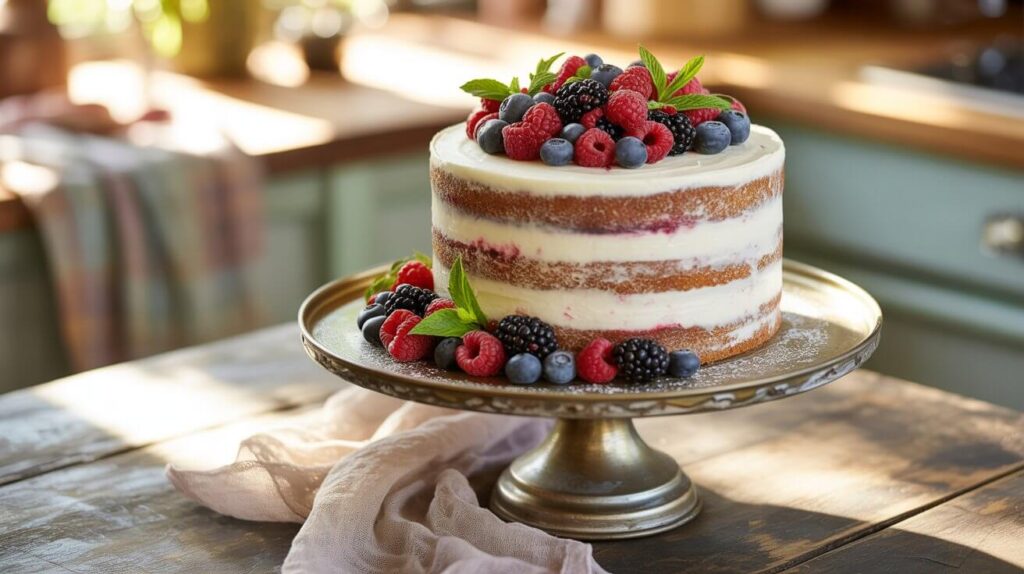
Conclusion
Naked cake decorating revolutionizes traditional baking by achieving stunning visual impact in just 10 minutes through strategic minimalism and embracing imperfection. This technique proves that beautiful cakes don’t require hours of complex decorating—instead, they celebrate natural textures, fresh ingredients, and rustic charm that feels both effortless and elegant for any occasion.
Ready to master this game-changing decorating technique? Try creating your first naked cake this weekend and share photos in our comments section! Subscribe to our blog for weekly baking tutorials, seasonal decorating ideas, and time-saving techniques that make every occasion special without the stress.
FAQs
Q: Can I make a naked cake without a turntable? A: Absolutely! While a turntable makes the process easier, you can achieve great results by rotating the cake plate manually. Work in small sections, turning the plate frequently to maintain even coverage and scraping patterns.
Q: How far in advance can I decorate a naked cake? A: For best results, complete naked cake decoration no more than 4 hours before serving. The exposed cake areas can dry out, and fresh toppings may wilt or lose their vibrant appearance with longer storage times.
Q: What’s the best frosting consistency for naked cakes? A: Aim for spreadable but not too soft—similar to room temperature butter. The frosting should hold its shape when scraped but spread smoothly without tearing the cake. If too stiff, add a tablespoon of milk; if too soft, chill briefly.
Q: Can I use store-bought frosting for naked cakes? A: Yes! Store-bought frosting works well for naked cakes. Let it come to room temperature and give it a quick whip to improve texture. The rustic aesthetic of naked cakes is forgiving and doesn’t require perfect homemade frosting.
Q: How do I prevent the cake layers from showing through too much? A: Apply a slightly thicker initial frosting layer, then scrape more gently. You want some cake to show through, but not large bare patches. Practice light, consistent pressure when scraping—you can always remove more frosting, but adding it back can look patchy.
Q: What if I don’t have fresh berries for decoration? A: Dried fruits, nuts, coconut flakes, or even simple powdered sugar dusting create beautiful naked cake presentations. The key is choosing elements that complement your cake flavor while maintaining the natural, understated aesthetic.
Q: Can naked cakes work for formal occasions? A: Definitely! Naked cakes can look very elegant with sophisticated toppings like fresh roses, gold leaf accents, or carefully arranged seasonal fruits. The key is choosing refined decorative elements that match your event’s formality level.
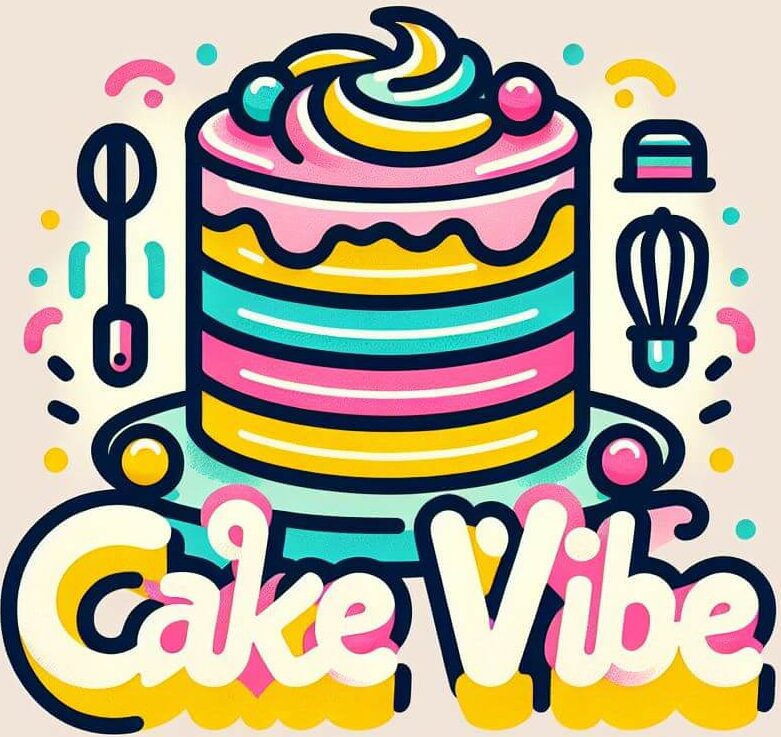
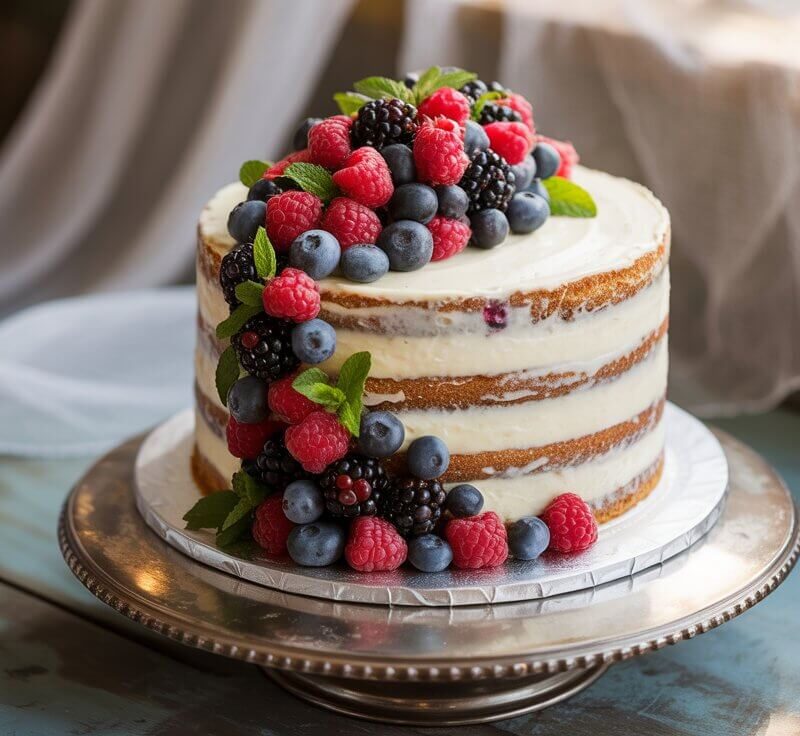
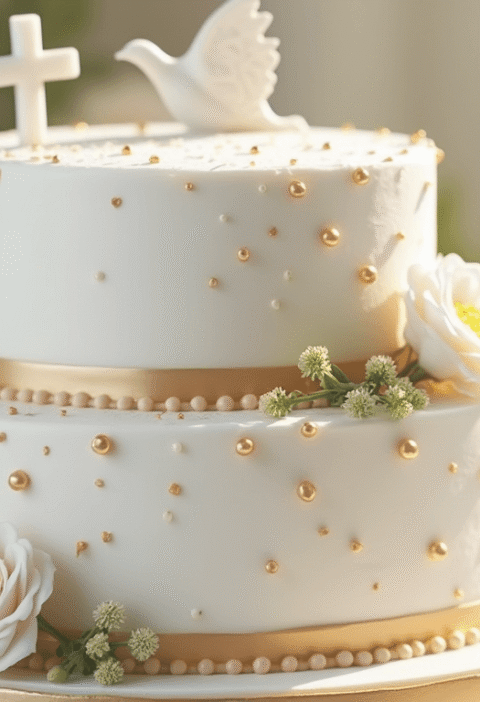

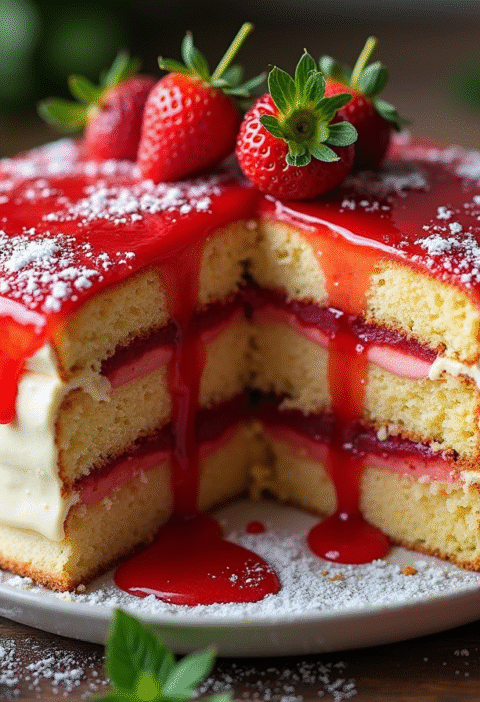
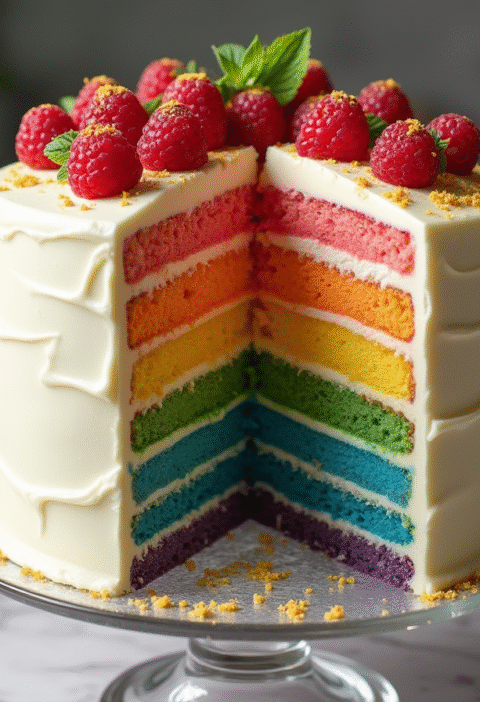
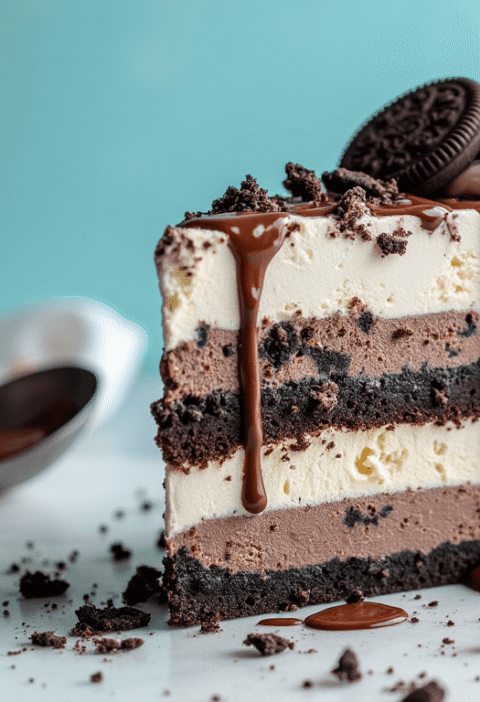
![Need a versatile base cake? This [White Cake Recipe] works for weddings, birthdays and more - learn the 3-step secret! Get baking now.](https://cakevibe.com/wp-content/uploads/2025/07/create_a_bright_inviting_food_photography-style_image_of_a_flawless_white_cake_with_the_following_d_vhb2hjeuw3rjdyt0li4n_0-1-480x702.png)